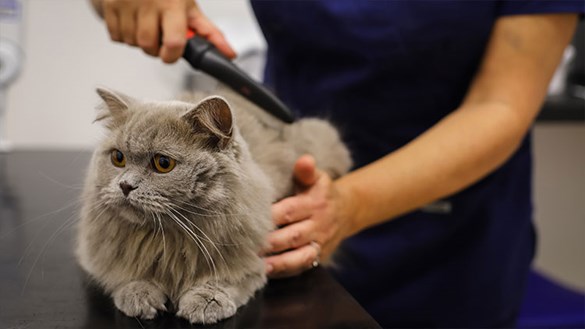Grooming Your Cat For Cold Weather
Cats need regular grooming throughout the colder months. Learn how to adapt your current grooming routine to keep your cat happy and healthy through winter.

Cats in cold weather
It’s a common misconception that cats don’t need regular grooming in cold weather. In fact, as the months start to get colder in the run-up to winter, it's important to adapt your cat’s grooming routine to keep them warm and comfortable.
Read on for our guide to cold weather grooming for your cat.
Coat
Cats shedding in winter
During autumn, your cat will shed their summer coat to allow for a thicker, warmer coat for the cold weather. While cats do a good job of grooming themselves, some will need extra help to keep their thick coat in check and prevent matting.
Regular brushing two to three times a week with a suitable brush or comb will help remove loose fur and prevent knots. Long-haired cats will need daily grooming to keep their coat in great condition. Start with a wide-toothed comb on small areas at a time to remove knots, then switch to a slicker brush to remove loose fur and dirt.
If you notice any matting, it’s important to deal with it right away before it gets worse. Speak to your vet for advice on how to remove it without causing pain or discomfort.
Regular grooming will also help prevent hairballs and gives you the opportunity to remove dead leaves or any other debris from their fur. If your cat gets caught out in the rain, always dry them thoroughly with a towel; warm, damp fur creates a perfect breeding ground for bacteria and infection.

Paws
The UK is famed for its rain, and as the weather gets wetter, your cat is more at risk of mucky and muddy paws. It’s important to regularly wipe off any excess dirt around their feet, making sure to get between their toes and under their nails. You can buy pet wipes to make this quicker and easier.
Doing this regularly gives you a chance to check for any bits of gravel or stone that may have become lodged between their toes which, if left unchecked, can cause severe pain and infection. Be careful though as most cats aren’t big fans of having their paws cleaned.
In the event of freezing weather, you should also watch out for chemical burns or rashes caused by gritting salt. If your cat’s feet look irritated, gently wash them with warm water and consider keeping them indoors until the irritation calms down. Rock salt can be toxic to cats, so always clean it off before they get a chance to lick it off.
Ears
Bits of leaves and grit can become lodged in your cat’s ears; always check them during your regular grooming sessions. Healthy ears should be clean and be free of odour, without redness or discharge.
Cats’ ears are extremely delicate and easily damaged, so avoid trying to clean them yourself, and never put anything in them as this can cause distress. If you think your cat’s ears need cleaning, or you have any concerns, speak to your vet.

Dry skin and dandruff in winter
Although your cat’s skin is protected by a thick layer of fur, it’s important to keep an eye on it, especially in the colder months. Central heating and extreme temperatures can dehydrate their skin and cause dandruff. If you spot flakes, consider investing in a humidifier to add moisture back into the air and increase the omega 3 in their diet.
If the dandruff doesn’t disappear or their skin becomes red and irritated, this could be a sign of an underlying condition, so speak to your vet as soon as possible.
Joints
Unfortunately, arthritis in cats often gets worse during cold weather, so it’s a good idea to check your cat for signs of joint trouble, particularly as they get older. If you notice their fur becomes unusually matted or scruffy, this may be a sign that they’re having trouble grooming themselves due to joint pain.
Look out for slowness and caution in their movements, or subtle limping which could also be signs of arthritis. If you suspect your cat may be suffering, speak to your vet for more advice.
Cat grooming in cold weather FAQs
Most cats will wisely opt to stay inside in the warmth when it’s cold outside, make sure that your cat is always able to get back into the house or that there’s a place for them to shelter in if you’re not around and don’t have a cat flap. Extra blankets in a dry spot will work well.
Your cat should be fine to venture outside when it’s cold. If it’s too cold they’ll quickly make their way back inside – they’re pretty smart like that. Your cat will let you know when they want to come back inside. Try to avoid leaving your cat outside while you go out for long periods of time if they have no cat flap.
Generally, we’d advise that anything below 7 degrees Celsius is too cold for a cat to go outside. If your cat is hairless, has a particularly short coat or is old, young or sick, this temperature will be much too low for them, and we’d strongly recommend that you keep them indoors, and warm.
Cats can get cold indoors, if your home is cold or damp. Cats are pretty good at finding somewhere to snuggle. Make sure there are plenty of blankets and an enclosed cat bed and they should be fine. A constantly chilly cat can cause many health problems, so we’d always recommend a warm bed, blankets and put the heating on if it’s really cold.
Cat’s will groom themselves regularly, but you should continue grooming your cat in cooler weather to look after their winter coat. If you have a longer haired or densely coated cat, it will need help to keep clean and free of dirt. You may find their coat gets dirtier in winter as they pick up fallen leaves and mud from the wetter ground.
Get advice on grooming your cat during the colder seasons – speak to your Medivet practice.

Our Pet Care Advice
At Medivet, we’re committed to providing trustworthy, expert advice that helps you care for your pet. Don't miss our latest advice for keeping your pets happy and healthy.
Search advice

Medivet Healthcare Plan
On average our clients save an average of £225 with the Medivet Healthcare Plan.
Learn more

